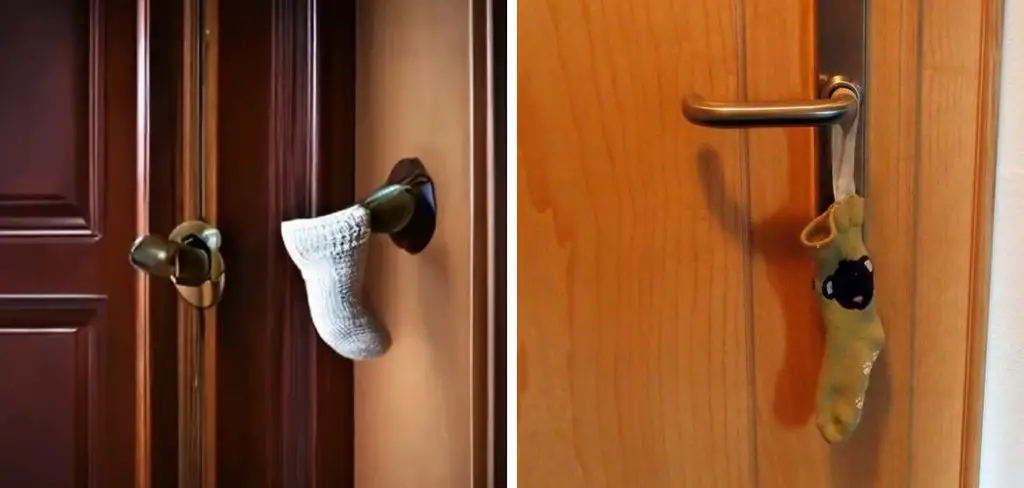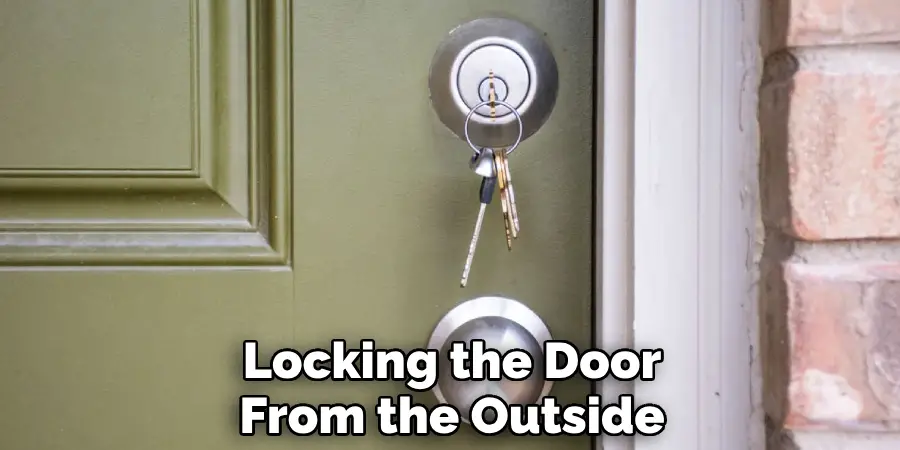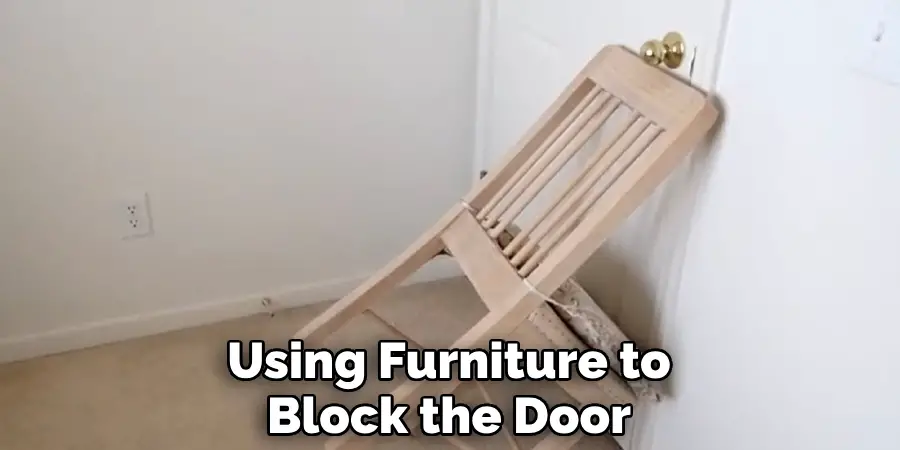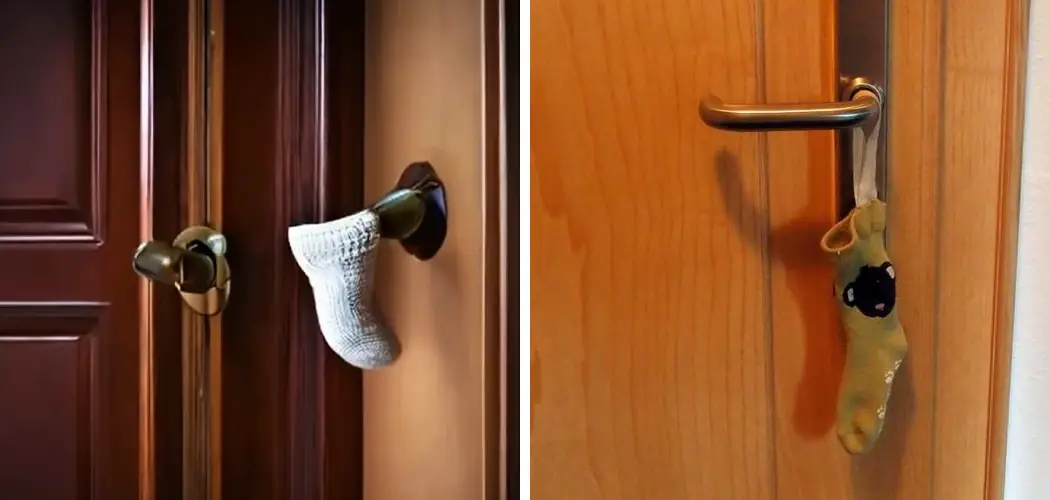Locking a door is an essential security measure that everyone should practice, whether at home or in public places. However, not everyone has access to traditional locks and keys. In some cases, you may find yourself in a situation where you need to lock a door using unconventional methods. One such method is using a sock.

Yes, you read that right – locking a door with a sock is possible and can be an effective temporary solution. In this guide, we will discuss how to lock a door with a sock and when it may come in handy.
Benefits of Locking a Door With a Sock
Aside from being a convenient and readily available solution, locking a door with a sock has several other benefits:
Cost-effective:
Traditional locks and key sets can be expensive, especially if you need to purchase them on short notice. Using a sock to secure a door is a cost-effective alternative that won’t break the bank.
Discreet:
Sometimes, you may not want others to know that you have locked a particular space or room. As socks are commonly worn and can easily be hidden, locking a door with one can be a discreet way to secure an area.
Portable:
Socks are lightweight and compact, making them easy to carry around. If you often find yourself in situations where you need to secure doors on the go, using a sock as a lock can be a practical solution
What You’ll Need
To lock a door with a sock, you will need the following items:
A Sturdy Door Handle or Knob
This method works best on doors with a sturdy handle or knob. If the door handle is flimsy or weak, it may not hold the sock in place.

A Sock:
Any type of sock will do, but it’s recommended to use a thicker material such as wool or cotton for better grip and durability. Avoid using thin or slippery socks.
A Door Frame:
The door needs to have a frame for this method to work. If the door opens into a room without a proper frame, the sock may not stay in place.
12 Step-by-step Guidelines on How to Lock a Door With a Sock
Step 1: Understanding the Need
Before using a sock to lock a door, it’s important to assess the situation and determine if it’s appropriate. For instance, this method may be useful in emergencies or when there is no other means available. It’s not recommended for long-term use or on doors that require high levels of security. You should also consider if the door can be locked from the inside or outside. But, if you’ve decided that using a sock is the best option, let’s proceed to the next step. You could also check with the door’s owner if it’s okay to use a sock as a lock instead of damaging or breaking it.
Step 2: Familiarizing Yourself With the Door Handle
Inspect the door handle to understand its mechanism. This will help you determine where best to place the sock for maximum security. It’s also essential to know which side of the door is the inside and outside. But, if you’re familiar with the door and its handle, skip to step 3. You may also skip this step if the door cannot be locked from the outside.

Step 3: Choosing the Right Sock
Select a sock that is long enough to wrap around the handle and has a good grip. Avoid using socks with holes or loose threads as they may not stay in place. The sock should also be clean to prevent damage to the door handle. It’s also a good idea to choose a sock that is similar in color to the door for better camouflage. If you don’t have a sock that fits these criteria, any clean sock will do. It’s better to use a clean sock than a dirty one that may cause damage.
Step 4: Positioning the Sock
Take the selected sock and place it over the door handle, making sure that it covers the entire handle. The toe area of the sock should face upwards towards the ceiling, while the opening should face downwards. But, if the door handle is vertical or has a lever, place the sock accordingly. You may also need to adjust the position of the sock based on how the door handle moves. However, make sure that the sock is wrapped tightly and securely around the handle.
Step 5: Creating a Knot
With the sock in place, take both ends and tie them together tightly. Make sure that the knot is secure, as it will hold the weight of the door when locked. If necessary, double knot or tie additional knots for extra security. The knot should also be close enough to the door handle for a snug fit. It’s important to note that the tighter the knot, the more secure the lock will be. The key is to find the right balance between tightness and ease of removal.
Step 6: Testing the Lock
Gently push or pull the door to test if it’s locked securely. If the sock moves, you may need to reposition it or tie a tighter knot. It’s crucial to ensure that the door is firmly held in place before leaving it unattended. If the door can be easily opened, the sock may not be an appropriate lock for that particular door. But, if the door stays shut, you have successfully locked it with a sock! The next step is to secure it further.

Step 7: Checking for Gaps
Look for an opening between the door and the frame. If there is a significant gap, you may need to tie another knot or use a thicker sock to fill it. Alternatively, you can also fold the sock over itself for extra padding. But, if there are no gaps or the door is tightly secured, you can skip this step. It’s essential to fill any spaces to prevent the door from being forced open. You can also use tape or paper to cover any gaps if necessary.
Step 8: Securing the Top of the Door
If your door has a considerable gap at the top, you may need to secure that as well. To do this, take the sock and fold it multiple times to create a long, thick strip. Place this strip on top of the door and close it gently. Make sure that the strip is tightly wedged between the door and the frame. You may also need to adjust the position of the sock until you find a snug fit. Although this step is optional, it can add an extra layer of security to the door.
Step 9: Preventing Sliding
To prevent the door from sliding open, take another sock and place it over the crack between the door and frame. The sock should cover the entire length of the gap. This method is particularly useful for doors with a latch or sliding lock mechanism. You can also tape or tie this extra sock to the first one if you want to secure it further. But, if your door doesn’t slide open, you can skip this step. You can also use this method in addition to the previous ones for better security.
Step 10: Locking the Door From The Inside
If you’re locking the door from the outside, be sure to leave a window or alternative exit available in case of an emergency. It’s also important to inform anyone inside about the lock and how to remove it. If you’re locking the door from the inside, make sure that you have a way to open it from the outside in case of an emergency. It’s crucial to consider safety measures when using this method. If the door can be locked from both sides, proceed to step 11.

Step 11: Removing the Sock
To remove the sock, untie or cut the knot and slide it off the handle carefully. If you’ve tied extra knots or used tape, make sure to remove those as well. Check if there are any damages to the sock or the door handle. If not, you can reuse the sock for locking the door again in the future. The sock may have some creases or marks from being tied, but those should disappear after washing. The most important thing is to remember to remove the sock before leaving, as it can be a potential safety hazard if left on for an extended period.
Step 12: Finding Alternative Methods
As mentioned earlier, using a sock to lock a door may not be suitable for all situations. It’s essential to explore other options if this method doesn’t work for your particular door or handle. Some alternatives include using a chair, belt, or even a rope to secure the door. You can also invest in a portable door lock or ask your landlord to install a more secure lock on the door. Each situation may require a different solution, so it’s best to assess your options and find what works best for you.
Remember, safety should always be a top priority when it comes to securing your home or personal space. And with these steps on how to lock a door with a sock in mind, you can feel more confident about locking your door with just a simple sock. So the next time you find yourself without a key, don’t panic – just grab a sock and secure that door!
Do You Need to Use Professionals?
Using a sock to lock a door can be a quick and easy solution in certain situations. However, if you frequently find yourself without a key or need to secure your door long-term, it may be best to seek professional assistance. Locksmiths have the necessary tools and expertise to install proper locks that will ensure the safety of your home or space.

They can also provide recommendations on the most suitable lock for your specific needs. It’s always better to invest in a secure and reliable locking mechanism for long-term use rather than relying on temporary solutions. So while using a sock can be a handy trick, it’s important to consider other options as well. Stay safe!
Troubleshooting and Common Issues
The Sock Keeps Slipping or Moving:
This could be due to a loose knot or an improper fit. Try retying the knot tighter or adjusting the position of the sock on the door handle.
The Door Can Still Be Forced Open:
If there are gaps between the door and frame, try adding more socks or padding to fill them. You can also use tape or paper to cover any openings.
The Door Won’t Close Properly:
This could be due to the sock being too thick or bulky. Try using a thinner sock or folding the sock over itself for a snug fit.
The Sock is Difficult to Remove:
If you’ve tied extra knots or used tape, it may take longer to remove the sock. Make sure to untie or cut all knots and remove any tape before attempting to remove the sock carefully.
The Door Doesn’t Have a Handle:
This method may not work for doors without a traditional handle. In this case, it’s best to find an alternative solution such as using furniture to block the door or asking for help from a professional locksmith.

Safety Concerns:
Always make sure that there is a way to open the door from the inside and inform anyone inside about the lock. If you’re locking the door from the outside, make sure that there is an alternative exit available in case of an emergency. It’s crucial to prioritize safety when using this method.
Remember, these troubleshooting tips on how to lock a door with a sock are just suggestions and may not work for every situation. It’s essential to assess your specific circumstances and find the best solution for you. If all else fails, it’s always a good idea to seek professional help from a locksmith or building manager.
Frequently Asked Questions
Q: Can I Use Any Type of Sock for This Method?
A: It’s best to use a clean, stretchy sock that will fit snugly over the door handle. Avoid using thick or bulky socks as they may not hold properly. It’s also important to use a sock that you don’t mind potentially damaging or throwing away after use. You can also use a sock with a pattern or design, as long as it doesn’t affect the functionality of the lock.
Q: Is This Method Effective For All Types of Doors?
A: No, this method may not work for all types of doors. It’s best to test it out and find alternative methods if necessary. Some doors may require a different approach due to their shape, handle style, or lock mechanism. It’s also important to consider the safety of the door and its surroundings before deciding on a locking method.
Q: Can I Lock a Door From Both Sides With This Method?
A: No, this method is typically used for locking doors from one side only. If you want to lock a door from both sides, it’s best to explore other options or methods. Alternatively, you can use this method as an additional layer of security along with the door’s existing lock.
Q: How Long Can I Leave a Door Locked with a Sock?
A: It’s not recommended to leave a door locked with a sock for an extended period. This method is meant for temporary use only, and it’s essential to remove the sock as soon as possible. Leaving a door locked for an extended period may cause damage or safety hazards, so it’s best to avoid doing so.
Q: Can I Use This Method on a Door with a Deadbolt?
A: It’s not recommended to use this method on a door with a deadbolt. The sock may interfere with the functionality of the deadbolt, and it’s best to find alternative ways to secure the door. As mentioned before, safety should always be a top priority when locking your door. It’s best to invest in proper locks and seek professional help if needed for a door with a deadbolt.

Conclusion
Locking a door with a sock is a creative and improvised solution that may be useful in situations where traditional locks are not available, or additional security is needed temporarily. It is an innovative measure that can provide peace of mind, leveraging the simplest of household items. However, it is crucial to underscore that this method is not a substitute for a standard, durable lock and should not be relied upon as a long-term security strategy. Additionally, safety and accessibility in emergency situations must remain a primary consideration.
For more robust and permanent solutions, one should consider investing in a high-quality lock system or consult a professional. Nonetheless, understanding how to lock a door with a sock adds a handy technique to your personal security toolkit for those moments when ingenuity is required.

